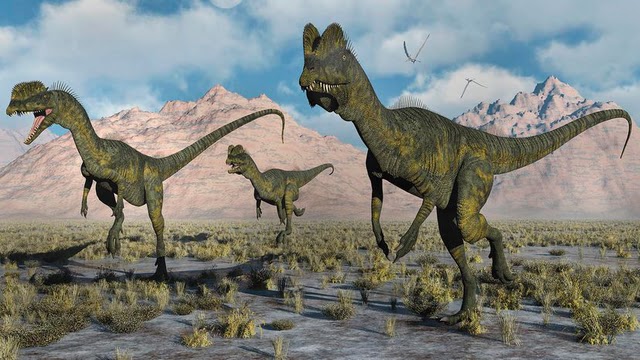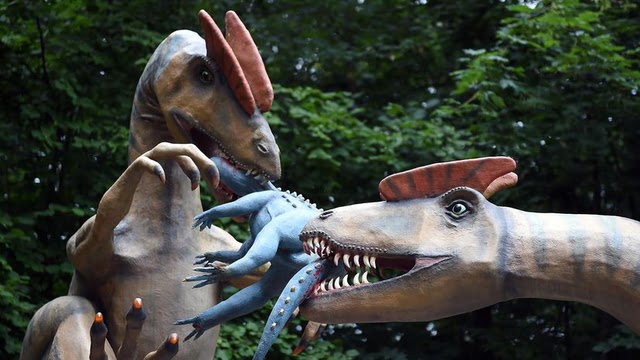Quck answer
The Dilophosaurus in the movie ‘Jurassic Park’ is not an accurate representation of the real animal. The real Dilophosaurus was much larger and did not have the ability to spit venom or expand its frill. It was a formidable predator with sharp teeth and claws, capable of taking down large prey. The ‘Jurassic Park’ version of the Dilophosaurus was made smaller and more docile for the movie, likely to make it more manageable on set. However, this portrayal has led to misconceptions about the real animal and its abilities.
Extinct Animals

During the Jurassic period, a group of Dilophosaurus dinosaurs, carnivores in nature, hunted for prey. Mark Stevenson/Stocktrek Images/Getty Images
If you’ve been following our dinosaur articles, you might have heard about the inaccuracies in the 1993 movie “Jurassic Park.” Though we love the movie, it did get some things wrong. For example, the Velociraptors in the film are much bigger than their actual size, and T. rex had no problem seeing objects that were not moving.
Arguably, no other dinosaur in the franchise was more misrepresented than the Dilophosaurus, a predator with a crest on its head. Ironically, Dilophosaurus was one of the few dinosaurs featured in the movie that actually lived during the Jurassic period.
Changing Times
All non-avian dinosaurs lived in the Mesozoic era, which was divided into three periods: the Triassic, the Jurassic, and the Cretaceous. The Cretaceous period ended with a mass extinction event that took place 66 million years ago, and only birds survived. Dinosaurs flourished during the Triassic period, which began around 243 million years ago. The Jurassic period followed about 199 million years ago, bringing with it the rise of larger carnivorous dinosaurs like Dilophosaurus.
Dilophosaurus, which lived about 183 to 193 million years ago in what is now Southwestern North America, measured over 20 feet (or 6 meters) long, making it the largest known land animal in North America at the time. Compared to previous flesh-eating dinosaurs, Dilophosaurus was a giant.
It’s strange, therefore, that the Dilophosaurus in “Jurassic Park” was small enough to fit in the front seat of a jeep.
Nedry’s Fate
Actor Wayne Knight played the character of Dennis Nedry, a disgruntled computer programmer in the original “Jurassic Park” movie. Nedry meets his end when a Dilophosaurus attacks him in the front seat of a park vehicle.
In the novel version of “Jurassic Park,” which the movie is based on, scientists believed that Dilophosaurus was primarily a scavenger with weak jaw muscles. However, they later discovered that the dinosaur was poisonous.

Two models of Dilophosaurus with a Scutellosaurus in its mouth on display at Saurierpark dinosaur park in Kleinwelka, Germany.
picture alliance/Getty Images
The Dilophosaurus in the movie spits venom into Nedry’s eyes after unfurling a neck frill similar to that of modern frilled lizards. However, there is no evidence to suggest that the real Dilophosaurus could do any of these things.
Although the idea of Dilophosaurus being a scavenger was not pulled out of thin air, there is no proof that the dinosaur actually preferred carrion. The Dilophosaurus in “Jurassic Park” is considered to be the most fictionalized of all the dinosaurs in the movie.
The Dilophosaurus dinosaur has a distinctive notch on either side of its upper jaw called the “subnarial gap,” located below its nasal openings. This feature is where two separate jawbones meet, both bearing teeth. Some experts believed that these bones were weakly connected, implying that Dilophosaurus did not have a strong bite and mainly ate corpses. However, new research published in the Journal of Paleontology in 2020 showed that the maxilla-premaxilla connection was stronger than previously thought. The lower jawbones also had scaffold-like attachment points for strong muscles, indicating that Dilophosaurus had powerful jaws. The dinosaur’s trademark feature is its flashy head crests, which were likely covered in keratin or keratinized skin. The purpose of the crests is unclear, but it is possible that they helped regulate body temperature or attract mates. Dilophosaurus is related to two other crested predators, Zupaysaurus and Cryolophosaurus, and their footprints have been found at Early Jurassic dig sites around the world. Most of our knowledge about Dilophosaurus comes from discoveries made on Navajo Nation land.
In 1942, Jesse Williams led a group of scientists to a Jurassic graveyard where they saw three Dilophosaurus. Two years after that, more scientists contacted Williams and he took them to the same site. The Navajo Nation legally owns multiple specimens of this dinosaur, which are currently held in trust at the University of California Museum of Paleontology. Samuel P. Welles, who named Dilophosaurus, had a long career at the museum before he passed away in 1997. Despite the scientific inaccuracies in “Jurassic Park”, Welles enjoyed the movie and was happy that Dilophosaurus became famous. In 2017, Connecticut chose Dilophosaurus as its official state dinosaur, as it’s possible that the predator responsible for some early Jurassic trackways found in the state was Dilophosaurus or a close relative.
FAQ
1. What is the Dilophosaurus?
The Dilophosaurus is a genus of theropod dinosaur that lived in what is now the western United States during the Early Jurassic period, around 193 to 183 million years ago.
2. How big was the Dilophosaurus?
The Dilophosaurus was a medium-sized dinosaur, standing around 6 feet tall and measuring up to 20 feet long.
3. How is the real Dilophosaurus different from the one in ‘Jurassic Park’?
The real Dilophosaurus was much larger and lacked the frill and ability to spit venom that the ‘Jurassic Park’ version had.
4. What did the real Dilophosaurus eat?
The real Dilophosaurus was a carnivore and likely ate small and medium-sized dinosaurs, as well as other animals such as reptiles and mammals.
5. When was the Dilophosaurus first discovered?
The first Dilophosaurus fossils were discovered in Arizona in 1942 by Samuel Paul Welles.
6. What does the name Dilophosaurus mean?
The name Dilophosaurus means “double-crested lizard” in reference to the two crests on the top of its head.
7. How fast could the Dilophosaurus run?
The Dilophosaurus was likely a fast runner, capable of reaching speeds up to 30 miles per hour.
8. Where can you see Dilophosaurus fossils?
Dilophosaurus fossils can be seen in museums around the world, including the American Museum of Natural History in New York and the Natural History Museum in London.
9. Was the Dilophosaurus a social animal?
It’s unclear whether the Dilophosaurus was a solitary animal or lived in groups, as there is limited evidence to suggest either.
10. How did the Dilophosaurus become extinct?
The Dilophosaurus, along with all other non-avian dinosaurs, became extinct around 66 million years ago due to a massive asteroid impact that caused a global environmental catastrophe.
11. Why is the Dilophosaurus important?
The Dilophosaurus is important because it provides valuable information about the evolution and behavior of theropod dinosaurs during the Early Jurassic period.





Leave a Reply